Detailed Project Report: Admin Block Construction, IISER Mohali
VerifiedAdded on 2023/06/01
|10
|1872
|250
Report
AI Summary
This report documents the construction of the Admin Block at the Indian Institute of Science Education and Research (IISER) in Mohali. The author, serving as a project trainee with Central PWD, Sub Division 1, details their involvement over a six-month period, from June to November 2013. The report outlines the project's background, objectives, and the trainee's responsibilities, including monitoring construction progress, ensuring material quality (concrete and steel), and conducting field tests like sieve analysis. Key activities included cube testing to assess concrete compressive strength, mix design for M25 grade concrete, and addressing issues encountered during testing, such as incorrect cube testing procedures and sieve analysis errors. The report also touches upon the theoretical understanding of framed structures, the application of engineering knowledge, and collaborative work with the project team. The project provided valuable experience in quality control and problem-solving within a construction environment. Desklib provides access to similar solved assignments and past papers for students.
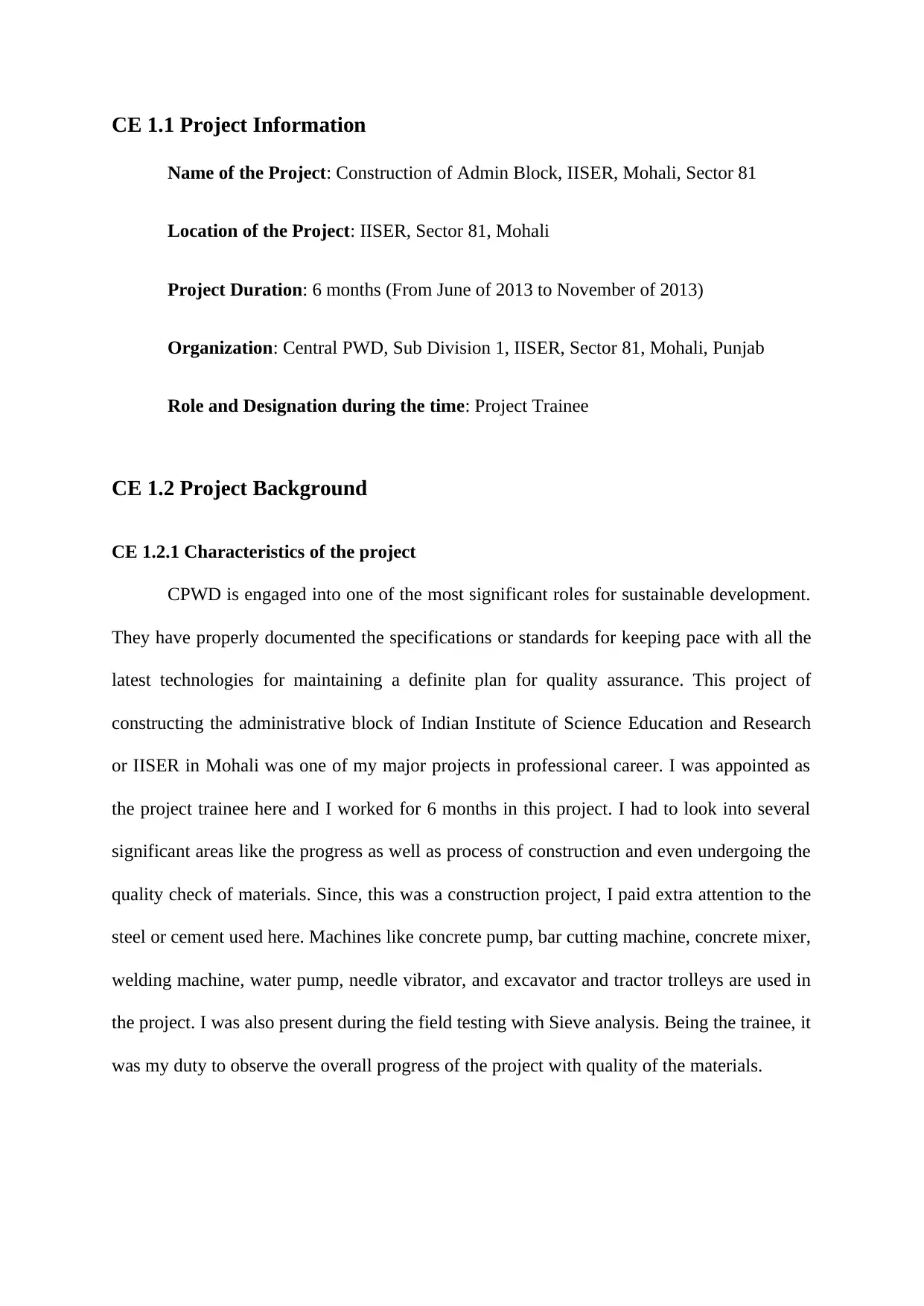
CE 1.1 Project Information
Name of the Project: Construction of Admin Block, IISER, Mohali, Sector 81
Location of the Project: IISER, Sector 81, Mohali
Project Duration: 6 months (From June of 2013 to November of 2013)
Organization: Central PWD, Sub Division 1, IISER, Sector 81, Mohali, Punjab
Role and Designation during the time: Project Trainee
CE 1.2 Project Background
CE 1.2.1 Characteristics of the project
CPWD is engaged into one of the most significant roles for sustainable development.
They have properly documented the specifications or standards for keeping pace with all the
latest technologies for maintaining a definite plan for quality assurance. This project of
constructing the administrative block of Indian Institute of Science Education and Research
or IISER in Mohali was one of my major projects in professional career. I was appointed as
the project trainee here and I worked for 6 months in this project. I had to look into several
significant areas like the progress as well as process of construction and even undergoing the
quality check of materials. Since, this was a construction project, I paid extra attention to the
steel or cement used here. Machines like concrete pump, bar cutting machine, concrete mixer,
welding machine, water pump, needle vibrator, and excavator and tractor trolleys are used in
the project. I was also present during the field testing with Sieve analysis. Being the trainee, it
was my duty to observe the overall progress of the project with quality of the materials.
Name of the Project: Construction of Admin Block, IISER, Mohali, Sector 81
Location of the Project: IISER, Sector 81, Mohali
Project Duration: 6 months (From June of 2013 to November of 2013)
Organization: Central PWD, Sub Division 1, IISER, Sector 81, Mohali, Punjab
Role and Designation during the time: Project Trainee
CE 1.2 Project Background
CE 1.2.1 Characteristics of the project
CPWD is engaged into one of the most significant roles for sustainable development.
They have properly documented the specifications or standards for keeping pace with all the
latest technologies for maintaining a definite plan for quality assurance. This project of
constructing the administrative block of Indian Institute of Science Education and Research
or IISER in Mohali was one of my major projects in professional career. I was appointed as
the project trainee here and I worked for 6 months in this project. I had to look into several
significant areas like the progress as well as process of construction and even undergoing the
quality check of materials. Since, this was a construction project, I paid extra attention to the
steel or cement used here. Machines like concrete pump, bar cutting machine, concrete mixer,
welding machine, water pump, needle vibrator, and excavator and tractor trolleys are used in
the project. I was also present during the field testing with Sieve analysis. Being the trainee, it
was my duty to observe the overall progress of the project with quality of the materials.
Paraphrase This Document
Need a fresh take? Get an instant paraphrase of this document with our AI Paraphraser
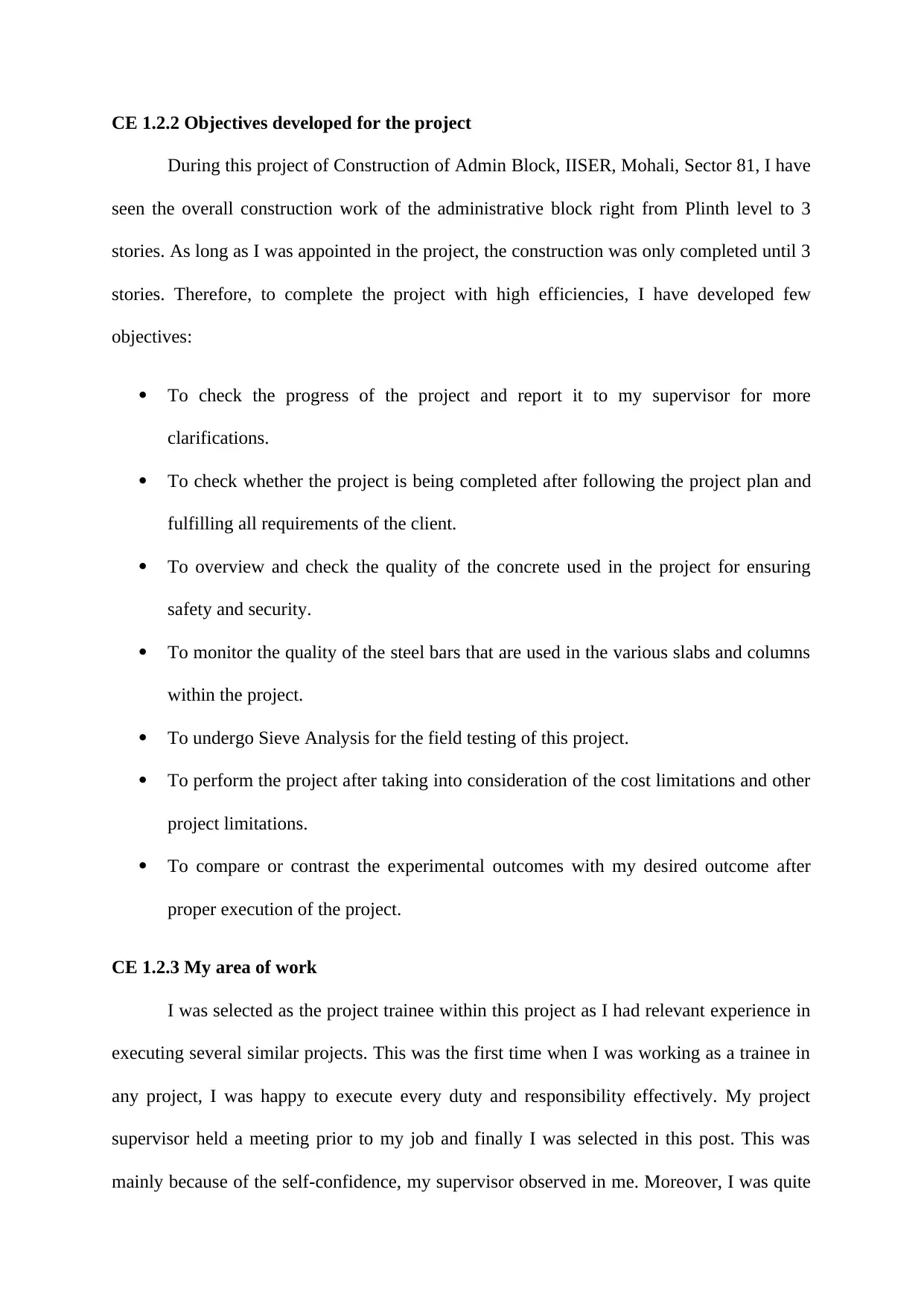
CE 1.2.2 Objectives developed for the project
During this project of Construction of Admin Block, IISER, Mohali, Sector 81, I have
seen the overall construction work of the administrative block right from Plinth level to 3
stories. As long as I was appointed in the project, the construction was only completed until 3
stories. Therefore, to complete the project with high efficiencies, I have developed few
objectives:
To check the progress of the project and report it to my supervisor for more
clarifications.
To check whether the project is being completed after following the project plan and
fulfilling all requirements of the client.
To overview and check the quality of the concrete used in the project for ensuring
safety and security.
To monitor the quality of the steel bars that are used in the various slabs and columns
within the project.
To undergo Sieve Analysis for the field testing of this project.
To perform the project after taking into consideration of the cost limitations and other
project limitations.
To compare or contrast the experimental outcomes with my desired outcome after
proper execution of the project.
CE 1.2.3 My area of work
I was selected as the project trainee within this project as I had relevant experience in
executing several similar projects. This was the first time when I was working as a trainee in
any project, I was happy to execute every duty and responsibility effectively. My project
supervisor held a meeting prior to my job and finally I was selected in this post. This was
mainly because of the self-confidence, my supervisor observed in me. Moreover, I was quite
During this project of Construction of Admin Block, IISER, Mohali, Sector 81, I have
seen the overall construction work of the administrative block right from Plinth level to 3
stories. As long as I was appointed in the project, the construction was only completed until 3
stories. Therefore, to complete the project with high efficiencies, I have developed few
objectives:
To check the progress of the project and report it to my supervisor for more
clarifications.
To check whether the project is being completed after following the project plan and
fulfilling all requirements of the client.
To overview and check the quality of the concrete used in the project for ensuring
safety and security.
To monitor the quality of the steel bars that are used in the various slabs and columns
within the project.
To undergo Sieve Analysis for the field testing of this project.
To perform the project after taking into consideration of the cost limitations and other
project limitations.
To compare or contrast the experimental outcomes with my desired outcome after
proper execution of the project.
CE 1.2.3 My area of work
I was selected as the project trainee within this project as I had relevant experience in
executing several similar projects. This was the first time when I was working as a trainee in
any project, I was happy to execute every duty and responsibility effectively. My project
supervisor held a meeting prior to my job and finally I was selected in this post. This was
mainly because of the self-confidence, my supervisor observed in me. Moreover, I was quite
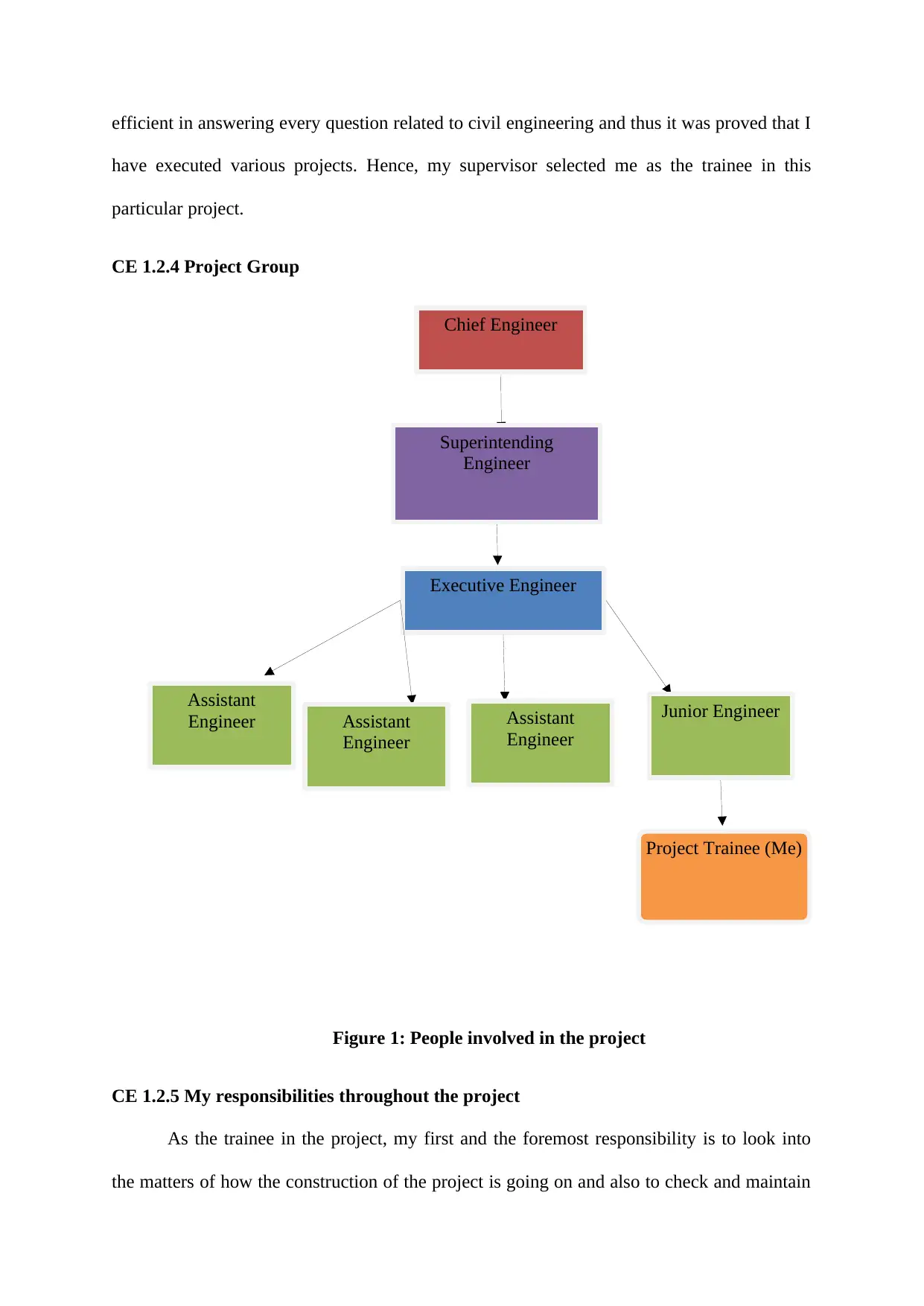
Chief Engineer
Superintending
Engineer
Executive Engineer
Assistant
Engineer Assistant
Engineer
Assistant
Engineer
Junior Engineer
Project Trainee (Me)
efficient in answering every question related to civil engineering and thus it was proved that I
have executed various projects. Hence, my supervisor selected me as the trainee in this
particular project.
CE 1.2.4 Project Group
Figure 1: People involved in the project
CE 1.2.5 My responsibilities throughout the project
As the trainee in the project, my first and the foremost responsibility is to look into
the matters of how the construction of the project is going on and also to check and maintain
Superintending
Engineer
Executive Engineer
Assistant
Engineer Assistant
Engineer
Assistant
Engineer
Junior Engineer
Project Trainee (Me)
efficient in answering every question related to civil engineering and thus it was proved that I
have executed various projects. Hence, my supervisor selected me as the trainee in this
particular project.
CE 1.2.4 Project Group
Figure 1: People involved in the project
CE 1.2.5 My responsibilities throughout the project
As the trainee in the project, my first and the foremost responsibility is to look into
the matters of how the construction of the project is going on and also to check and maintain
⊘ This is a preview!⊘
Do you want full access?
Subscribe today to unlock all pages.

Trusted by 1+ million students worldwide
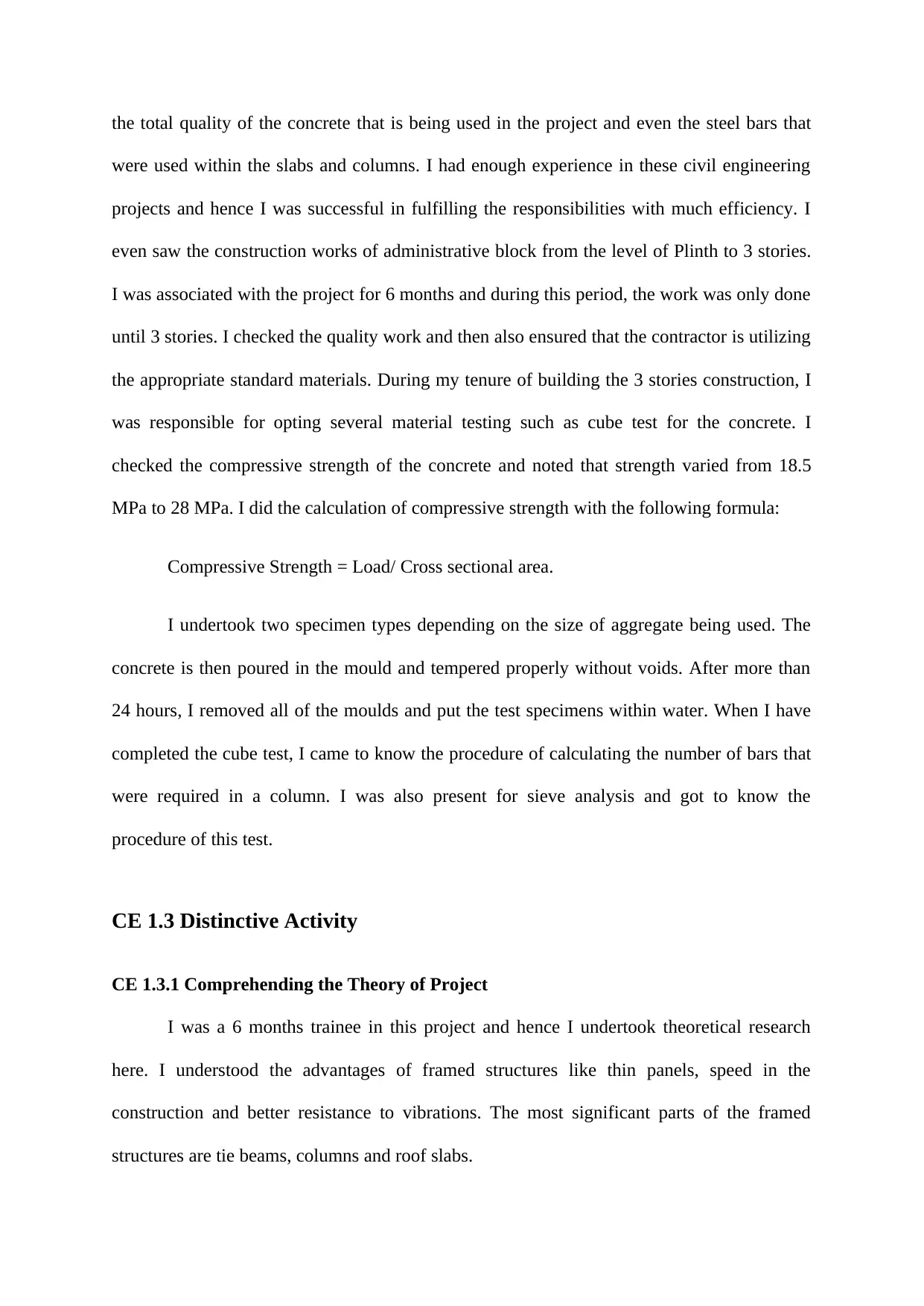
the total quality of the concrete that is being used in the project and even the steel bars that
were used within the slabs and columns. I had enough experience in these civil engineering
projects and hence I was successful in fulfilling the responsibilities with much efficiency. I
even saw the construction works of administrative block from the level of Plinth to 3 stories.
I was associated with the project for 6 months and during this period, the work was only done
until 3 stories. I checked the quality work and then also ensured that the contractor is utilizing
the appropriate standard materials. During my tenure of building the 3 stories construction, I
was responsible for opting several material testing such as cube test for the concrete. I
checked the compressive strength of the concrete and noted that strength varied from 18.5
MPa to 28 MPa. I did the calculation of compressive strength with the following formula:
Compressive Strength = Load/ Cross sectional area.
I undertook two specimen types depending on the size of aggregate being used. The
concrete is then poured in the mould and tempered properly without voids. After more than
24 hours, I removed all of the moulds and put the test specimens within water. When I have
completed the cube test, I came to know the procedure of calculating the number of bars that
were required in a column. I was also present for sieve analysis and got to know the
procedure of this test.
CE 1.3 Distinctive Activity
CE 1.3.1 Comprehending the Theory of Project
I was a 6 months trainee in this project and hence I undertook theoretical research
here. I understood the advantages of framed structures like thin panels, speed in the
construction and better resistance to vibrations. The most significant parts of the framed
structures are tie beams, columns and roof slabs.
were used within the slabs and columns. I had enough experience in these civil engineering
projects and hence I was successful in fulfilling the responsibilities with much efficiency. I
even saw the construction works of administrative block from the level of Plinth to 3 stories.
I was associated with the project for 6 months and during this period, the work was only done
until 3 stories. I checked the quality work and then also ensured that the contractor is utilizing
the appropriate standard materials. During my tenure of building the 3 stories construction, I
was responsible for opting several material testing such as cube test for the concrete. I
checked the compressive strength of the concrete and noted that strength varied from 18.5
MPa to 28 MPa. I did the calculation of compressive strength with the following formula:
Compressive Strength = Load/ Cross sectional area.
I undertook two specimen types depending on the size of aggregate being used. The
concrete is then poured in the mould and tempered properly without voids. After more than
24 hours, I removed all of the moulds and put the test specimens within water. When I have
completed the cube test, I came to know the procedure of calculating the number of bars that
were required in a column. I was also present for sieve analysis and got to know the
procedure of this test.
CE 1.3 Distinctive Activity
CE 1.3.1 Comprehending the Theory of Project
I was a 6 months trainee in this project and hence I undertook theoretical research
here. I understood the advantages of framed structures like thin panels, speed in the
construction and better resistance to vibrations. The most significant parts of the framed
structures are tie beams, columns and roof slabs.
Paraphrase This Document
Need a fresh take? Get an instant paraphrase of this document with our AI Paraphraser

I had to check the overall procedure for laying the tie beams. The first and the
foremost step in this process was shuttering of beams. In this step, I did the setup of these
beams. I even checked for two important precautions for maintaining safety and security
within the beam size. The second step is laying of steel; as per the reinforcement details, I
had to complete the laying as well as steel bending according to instructions. The other steps
were concrete casting, curing and removal of shuttering.
I have done cube test for checking the quality of the concrete and also to know about
the compressive strength. All of the specimens of concrete were tested by the compression
testing machine after 7 days or 28 days curing. I applied load at the rate of 140 kg/cm 2 in one
minute until the failure of specimens.
Figure 2: Cube Test of Concrete
CE 1.3.2 Engineering knowledge and skills applied in the project
To complete this project, I have utilized my knowledge of structural analysis and
designing. Since, I was appointed as a trainee in this project; I had to apply my knowledge
and skills of civil engineering. I have also applied my understanding of construction
engineering and building technology to check the overall progress of the work. For checking
the compressive strength of concrete in columns, I have used my knowledge of cube testing
foremost step in this process was shuttering of beams. In this step, I did the setup of these
beams. I even checked for two important precautions for maintaining safety and security
within the beam size. The second step is laying of steel; as per the reinforcement details, I
had to complete the laying as well as steel bending according to instructions. The other steps
were concrete casting, curing and removal of shuttering.
I have done cube test for checking the quality of the concrete and also to know about
the compressive strength. All of the specimens of concrete were tested by the compression
testing machine after 7 days or 28 days curing. I applied load at the rate of 140 kg/cm 2 in one
minute until the failure of specimens.
Figure 2: Cube Test of Concrete
CE 1.3.2 Engineering knowledge and skills applied in the project
To complete this project, I have utilized my knowledge of structural analysis and
designing. Since, I was appointed as a trainee in this project; I had to apply my knowledge
and skills of civil engineering. I have also applied my understanding of construction
engineering and building technology to check the overall progress of the work. For checking
the compressive strength of concrete in columns, I have used my knowledge of cube testing

and for field testing, I have checked sieve analysis. After cube testing, I have obtained results
in this test.
CE 1.3.3 Accomplishment and Task Performed
I have done the mix designing of cement in two categories of nominal mixes and
designed mixes. At site, the mix of M25 is being utilized for the construction of
administrative block.
For M25, I did the corrections and adjustments according to IS 10262-1982, the final
quantities for 1m3 of concrete were:
Actual water quantity = 176 lt
Actual cement quantity = 390 kg
Actual sand quantity = 540 kg
Actual coarse aggregate quantity = 1272 kg.
I took 848 kg for 20mm column and 424 kg for 10mm column.
Table 1: Ratio of Concrete Mix
in this test.
CE 1.3.3 Accomplishment and Task Performed
I have done the mix designing of cement in two categories of nominal mixes and
designed mixes. At site, the mix of M25 is being utilized for the construction of
administrative block.
For M25, I did the corrections and adjustments according to IS 10262-1982, the final
quantities for 1m3 of concrete were:
Actual water quantity = 176 lt
Actual cement quantity = 390 kg
Actual sand quantity = 540 kg
Actual coarse aggregate quantity = 1272 kg.
I took 848 kg for 20mm column and 424 kg for 10mm column.
Table 1: Ratio of Concrete Mix
⊘ This is a preview!⊘
Do you want full access?
Subscribe today to unlock all pages.

Trusted by 1+ million students worldwide
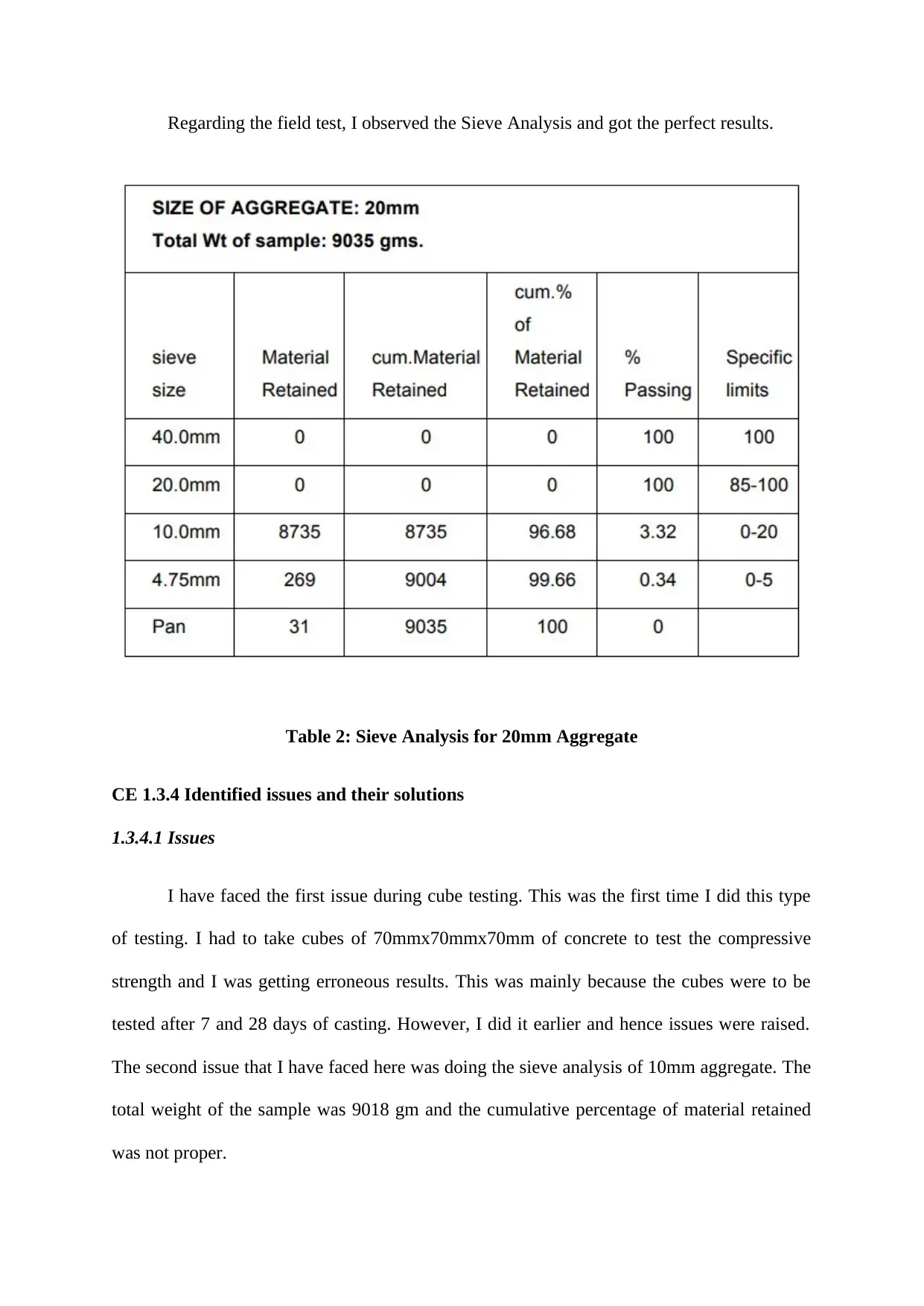
Regarding the field test, I observed the Sieve Analysis and got the perfect results.
Table 2: Sieve Analysis for 20mm Aggregate
CE 1.3.4 Identified issues and their solutions
1.3.4.1 Issues
I have faced the first issue during cube testing. This was the first time I did this type
of testing. I had to take cubes of 70mmx70mmx70mm of concrete to test the compressive
strength and I was getting erroneous results. This was mainly because the cubes were to be
tested after 7 and 28 days of casting. However, I did it earlier and hence issues were raised.
The second issue that I have faced here was doing the sieve analysis of 10mm aggregate. The
total weight of the sample was 9018 gm and the cumulative percentage of material retained
was not proper.
Table 2: Sieve Analysis for 20mm Aggregate
CE 1.3.4 Identified issues and their solutions
1.3.4.1 Issues
I have faced the first issue during cube testing. This was the first time I did this type
of testing. I had to take cubes of 70mmx70mmx70mm of concrete to test the compressive
strength and I was getting erroneous results. This was mainly because the cubes were to be
tested after 7 and 28 days of casting. However, I did it earlier and hence issues were raised.
The second issue that I have faced here was doing the sieve analysis of 10mm aggregate. The
total weight of the sample was 9018 gm and the cumulative percentage of material retained
was not proper.
Paraphrase This Document
Need a fresh take? Get an instant paraphrase of this document with our AI Paraphraser
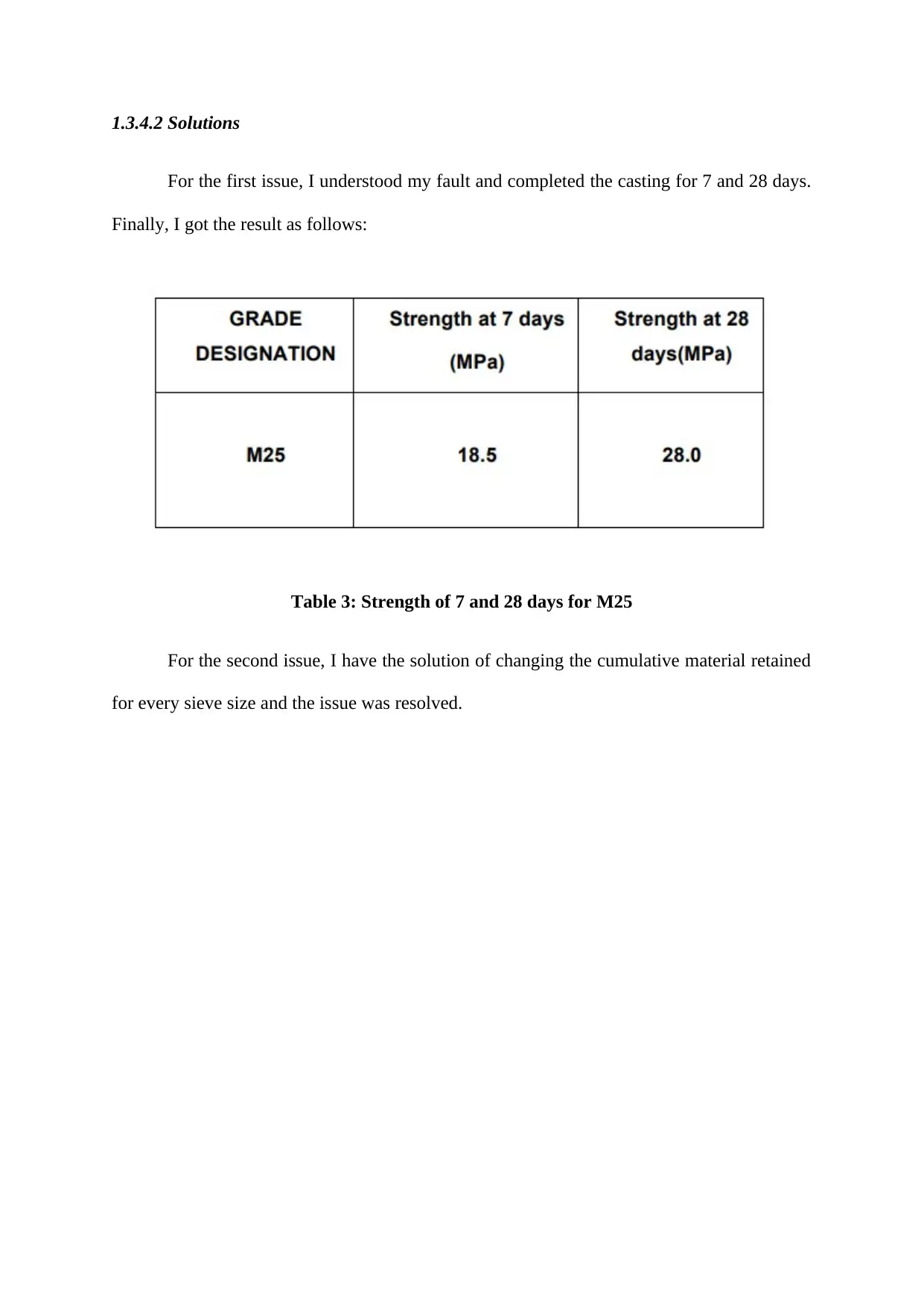
1.3.4.2 Solutions
For the first issue, I understood my fault and completed the casting for 7 and 28 days.
Finally, I got the result as follows:
Table 3: Strength of 7 and 28 days for M25
For the second issue, I have the solution of changing the cumulative material retained
for every sieve size and the issue was resolved.
For the first issue, I understood my fault and completed the casting for 7 and 28 days.
Finally, I got the result as follows:
Table 3: Strength of 7 and 28 days for M25
For the second issue, I have the solution of changing the cumulative material retained
for every sieve size and the issue was resolved.

Table 4: Sieve Analysis Results of 10mm
CE 1.3.5 Plan to produce creative and innovative work
I had prepared the distinct plans to accomplish the works with higher effectiveness
and efficiencies. I have also attended various workshops before initiating my work. I
consulted with various teachers working in domain of civil engineering.
CE 1.3.6 Collaborative Work
Collaboration of work was one of the major factors in this specific project. I provided
the weekly progress report to my project supervisor. Being the team leader, I even
communicated with my team and took follow ups. I also gave presentations in front of the
chief engineer after every two months.
CE 1.3.5 Plan to produce creative and innovative work
I had prepared the distinct plans to accomplish the works with higher effectiveness
and efficiencies. I have also attended various workshops before initiating my work. I
consulted with various teachers working in domain of civil engineering.
CE 1.3.6 Collaborative Work
Collaboration of work was one of the major factors in this specific project. I provided
the weekly progress report to my project supervisor. Being the team leader, I even
communicated with my team and took follow ups. I also gave presentations in front of the
chief engineer after every two months.
⊘ This is a preview!⊘
Do you want full access?
Subscribe today to unlock all pages.

Trusted by 1+ million students worldwide
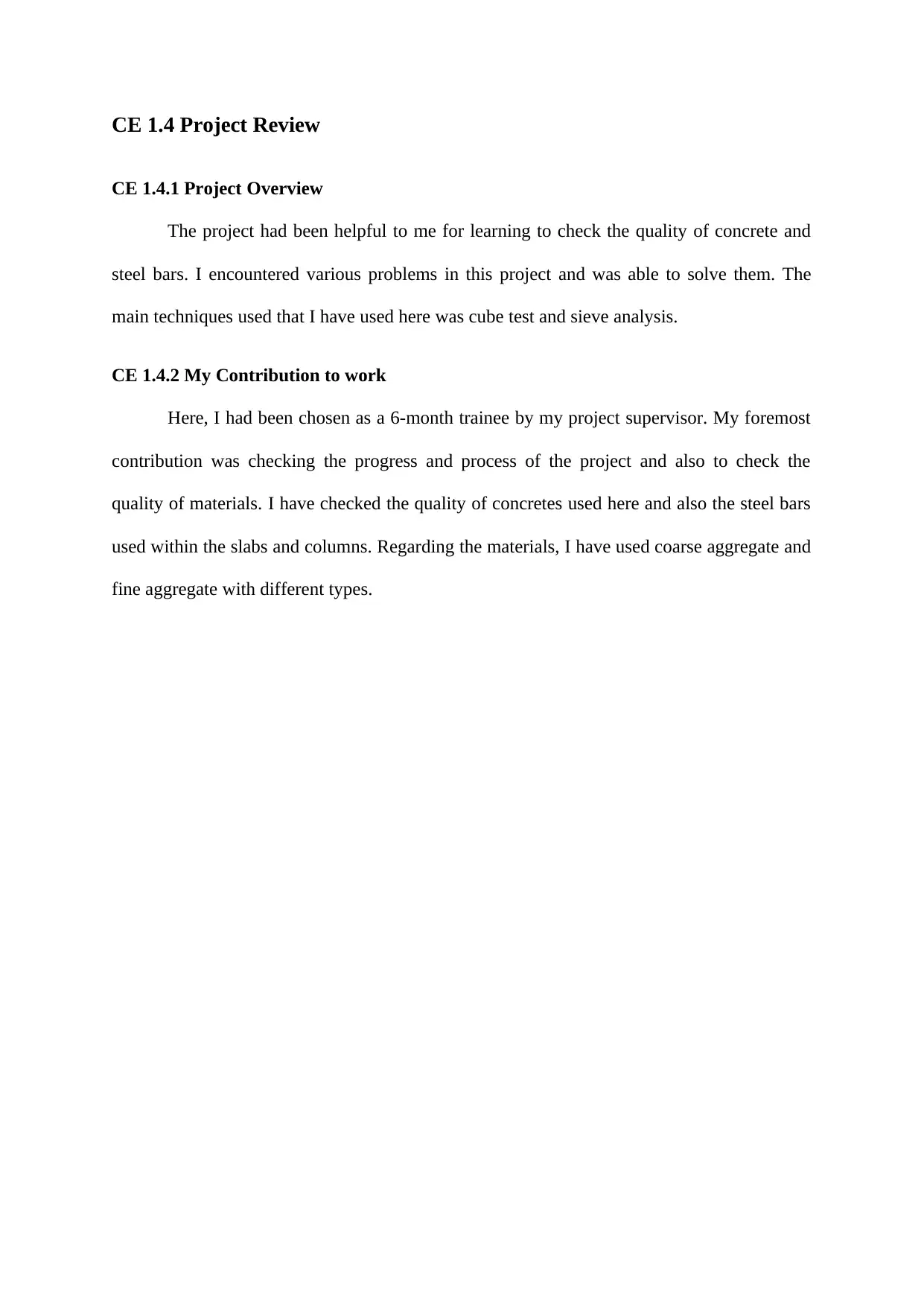
CE 1.4 Project Review
CE 1.4.1 Project Overview
The project had been helpful to me for learning to check the quality of concrete and
steel bars. I encountered various problems in this project and was able to solve them. The
main techniques used that I have used here was cube test and sieve analysis.
CE 1.4.2 My Contribution to work
Here, I had been chosen as a 6-month trainee by my project supervisor. My foremost
contribution was checking the progress and process of the project and also to check the
quality of materials. I have checked the quality of concretes used here and also the steel bars
used within the slabs and columns. Regarding the materials, I have used coarse aggregate and
fine aggregate with different types.
CE 1.4.1 Project Overview
The project had been helpful to me for learning to check the quality of concrete and
steel bars. I encountered various problems in this project and was able to solve them. The
main techniques used that I have used here was cube test and sieve analysis.
CE 1.4.2 My Contribution to work
Here, I had been chosen as a 6-month trainee by my project supervisor. My foremost
contribution was checking the progress and process of the project and also to check the
quality of materials. I have checked the quality of concretes used here and also the steel bars
used within the slabs and columns. Regarding the materials, I have used coarse aggregate and
fine aggregate with different types.
1 out of 10
Your All-in-One AI-Powered Toolkit for Academic Success.
+13062052269
info@desklib.com
Available 24*7 on WhatsApp / Email
![[object Object]](/_next/static/media/star-bottom.7253800d.svg)
Unlock your academic potential
Copyright © 2020–2025 A2Z Services. All Rights Reserved. Developed and managed by ZUCOL.
